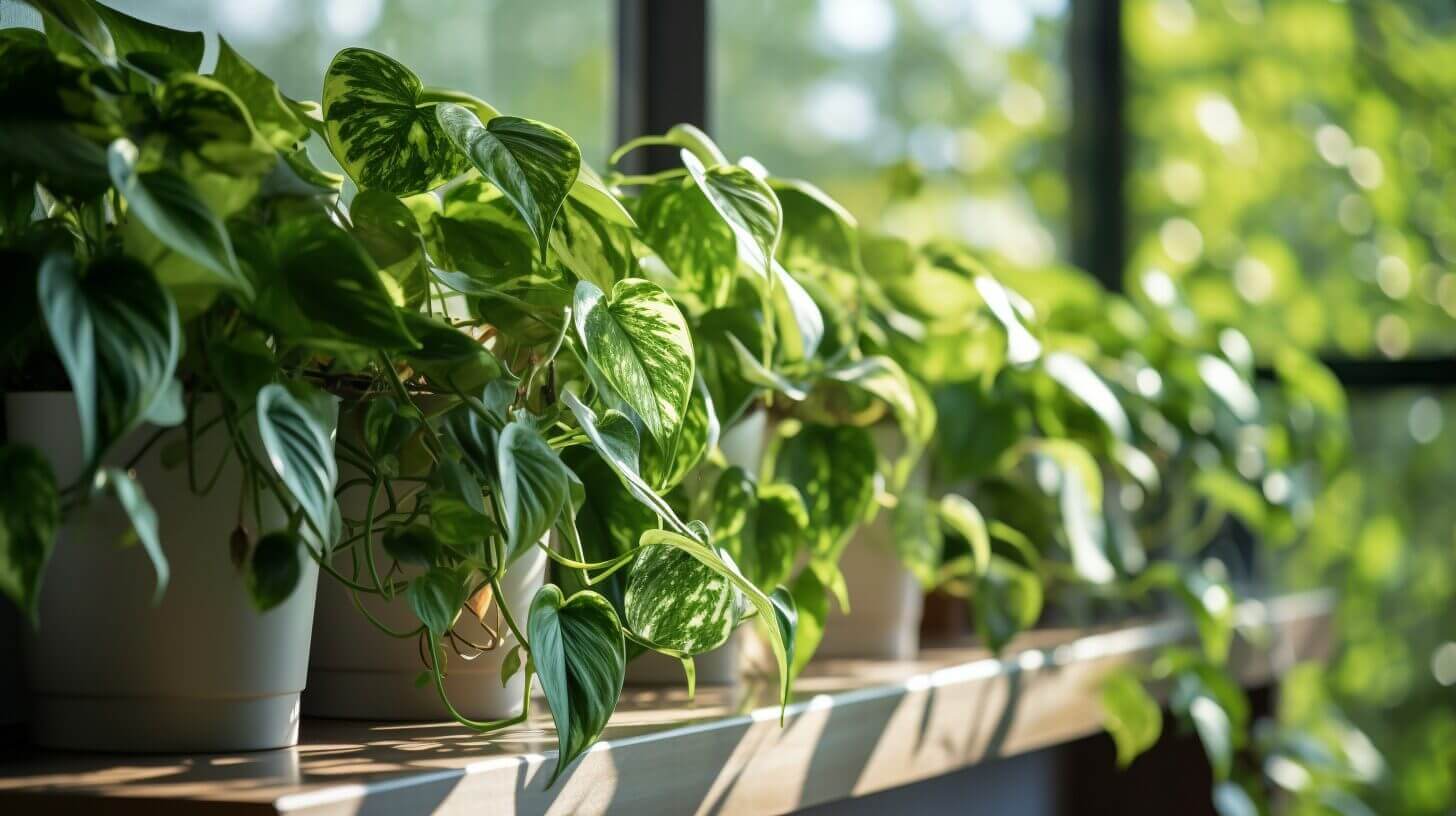How Much Light Do Pothos Need? Finding the Perfect Spot
Discover the secrets to finding the perfect spot for your beloved pothos plant.
Like a sun-seeking traveler, this resilient green beauty yearns for just the right amount of light to thrive.
In this article, we will delve into the intricate dance between sunlight and pothos, unraveling the mysteries of its light requirements.
By the end, you will possess the knowledge to create an ideal indoor environment, ensuring your pothos flourishes with vibrant foliage and robust health.
Welcome to the enlightening journey of pothos care.
Key Takeaways
- Pothos plants prefer bright and indirect natural light, but can tolerate a range of light intensities.
- South-facing windows provide intense sunlight, while north-facing windows receive the least.
- Pothos requires a minimum of 4-6 hours of sunlight per day, but around 6-8 hours is ideal.
- If natural light is limited, consider using artificial lighting options, such as LED grow lights, to supplement the light needs of your pothos.
Understanding Pothos Light Requirements
Although pothos plants are known for their low light tolerance, it is essential to understand the specific light requirements of each pothos variety to ensure optimal growth and health.
When it comes to providing light for your pothos, you have two options: natural light or artificial light. Natural light is the preferred choice as it provides the necessary spectrum of light that plants need for photosynthesis. Place your pothos near a north or east-facing window where it can receive bright, indirect light. Avoid placing it in direct sunlight as this can scorch the leaves.
If natural light is limited, you can supplement it with artificial light. LED grow lights are a popular choice as they provide the right spectrum of light and are energy-efficient. When using artificial light, position it about 6 to 12 inches above the pothos to ensure adequate coverage.
One common mistake in providing light for pothos is overexposing them to direct sunlight, leading to sunburned leaves. Another mistake is placing them too far from a light source, resulting in weak and leggy growth. It is important to find the right balance and monitor the plant’s response to light.
Understanding the specific light requirements of each pothos variety and avoiding these common mistakes will help you provide optimal light conditions for your pothos, ensuring its growth and health.
Is Your Pothos Getting Enough Light? Direct vs. Indirect lighting
To determine the suitability of your home’s sunlight for pothos, it is crucial to assess the intensity and duration of natural light exposure in different areas of your living space. Evaluating natural light is essential to ensure optimal growth and health of your pothos plant.
Here are some key factors to consider:
- Direction of sunlight: Pothos plants thrive in bright, indirect light. Assess the areas in your home that receive sunlight for a significant part of the day. South-facing windows usually provide the most intense sunlight, while north-facing windows receive the least.
- Intensity of light: Pothos plants can tolerate a range of light intensities, from low to medium. However, if the light is too dim, the plant may become leggy and lose its vibrant green color. On the other hand, excessive direct sunlight can scorch the leaves. Finding a spot with moderate but bright light is ideal.
- Duration of light exposure: Pothos plants require a minimum of 4-6 hours of sunlight per day to thrive. Determine the areas in your home that receive this duration of sunlight and consider placing your pothos there.
If your home lacks sufficient natural light, don’t worry! There are artificial lighting options available, such as fluorescent or LED grow lights, that can provide the necessary light for your pothos. These lights can be adjusted to mimic natural sunlight and ensure the plant’s growth and vitality.
Finding the Ideal Spot With Adequate Light for Your Pothos
Determining the best location for your pothos indoors involves considering factors such as light intensity and duration, as well as assessing the plant’s water and humidity requirements. Pothos plants thrive in bright, indirect light, making them ideal for indoor spaces that receive natural sunlight. When choosing the perfect spot for your pothos, look for areas with bright, filtered light, such as near a north or east-facing window. Avoid placing them in direct sunlight, as this can scorch the leaves and cause them to turn yellow.
In addition to light intensity, it’s important to consider the duration of light exposure. Pothos plants require around 6-8 hours of light per day to thrive. If your chosen location doesn’t provide enough light, you can supplement with artificial lighting. LED grow lights are a great option as they provide the ideal lighting spectrum for plant growth.
Finding the ideal indoor spot for your pothos is crucial for its growth and health. In the next section, we will discuss how to adjust light levels to ensure your pothos receives the right amount of light for optimal growth.
Adjusting Light Levels for Pothos’ Growth and Health
Optimizing light exposure is essential for promoting the healthy growth and development of pothos plants. Adjusting light intensity and experimenting with different light sources can make a significant difference in the overall health and vitality of your pothos. Here are three key considerations for finding the perfect light balance:
- Light intensity: Pothos plants thrive in bright, indirect light. Too much direct sunlight can scorch their leaves, while insufficient light can result in weak, leggy growth. Adjusting the light intensity by placing your pothos near a window with sheer curtains or in a well-lit room can help provide the optimal amount of light for their growth.
- Light duration: Pothos plants require about 10-12 hours of light per day. To ensure they receive adequate light, consider placing them near a window or using artificial grow lights. Experiment with different durations and monitor the growth and health of your pothos to find the right balance.
- Light sources: Pothos plants can thrive under fluorescent or LED lights. These light sources provide the necessary spectrum for their growth and can be adjusted to different intensities. Experimenting with different light sources can help you find the one that works best for your pothos.
By adjusting light intensity, experimenting with different light sources, and considering the duration of light exposure, you can maintain the perfect light balance for your pothos plants.
Now, let’s explore some tips for maintaining this balance and ensuring the health and vitality of your pothos.
Maintaining the Right Amount of Light to Grow Pothos
How can one effectively maintain the perfect light balance for pothos plants? Maintaining healthy pothos growth requires finding the right amount of light for these popular houseplants. Pothos plants thrive in bright, indirect light, making them versatile and adaptable to a variety of lighting conditions. However, it is essential to strike the perfect balance to ensure their optimal health and growth.
To maintain the perfect light balance for your pothos plants, consider a few key tips. First, observe the plant closely to determine if it is receiving too much or too little light. Signs of insufficient light include pale leaves, weak growth, and a leggy appearance. On the other hand, if the leaves start to develop brown spots or become scorched, it may be receiving too much light.
To troubleshoot common light issues, you can move the pothos to a different location within your home. If it is not receiving enough light, try placing it near a window with bright, indirect light. Alternatively, if the plant is getting too much light, move it away from direct sunlight or place it in a spot with filtered light.
Regularly rotating the plant can also help to ensure even light distribution on all sides, promoting balanced growth. By monitoring your pothos plants closely and making adjustments as necessary, you can maintain the perfect light balance and enjoy healthy, vibrant growth.
Frequently Asked Questions
Does the Amount of Light Pothos Plants Receive Affect How Often They Need to be Watered?
The amount of light that Pothos plants receive directly impacts their watering needs. Adequate light helps plants to photosynthesize and regulate moisture levels. Insufficient light results in slower growth and less water consumption. Conversely, excessive light can cause the soil to dry out quickly. Therefore, proper light conditions are crucial for watering your pothos plant effectively.
Can I Keep My Pothos Plant Outdoors in Direct Sunlight?
Keeping a pothos plant outdoors in direct sunlight can be detrimental to its health. Pothos plants are typically better suited for indoor environments, where they thrive in indirect sunlight. Exposure to direct sunlight for extended periods can lead to leaf burn and damage.
Indirect sunlight provides the perfect balance for the pothos, allowing it to grow and flourish. Therefore, it is advisable to keep your pothos plant indoors, where it can benefit from the gentle, filtered light.
Can I Use Artificial Light to Provide Sufficient Light for My Pothos Plant?
Using artificial light to provide sufficient light for a pothos plant is akin to using a flashlight to navigate through a dark forest. While grow lights can mimic natural sunlight to some extent, they cannot fully replicate the benefits that plants receive from the sun’s rays.
Natural sunlight provides a wide spectrum of light, including UV rays, which are essential for plant growth and health. Therefore, while artificial light can be a temporary solution, it is best to place pothos plants in a spot where they can receive ample natural sunlight.
How Do I Know if My Pothos Plant Is Getting Too Much Light?
Knowing if a pothos plant is getting too much light is crucial for its health. Signs of overexposure include yellowing or browning of leaves, leaf burn, and stunted growth.
To ensure optimal light levels, adjust the plant’s position accordingly. Move your Pothos away from direct light or bright windows if symptoms occur.
Conversely, if the plant appears leggy and pale, it may be receiving insufficient light. Experiment with different locations until you find the perfect spot that meets your pothos’ light requirements.
How Often Should I Rotate My Pothos Plant to Ensure It Gets Even Light Exposure?
To ensure optimal light exposure for your pothos plant, regular rotation is essential. By rotating the plant every two to three weeks, you can ensure that all sides receive even amounts of light, promoting balanced growth and preventing the plant from leaning towards the light source.
This practice is especially important if your pothos is placed in a low light area. By following this simple care routine, you will be able to maintain a healthy and thriving pothos plant.
How much light does a pothos need?
Pothos plants thrive in bright indirect light, but they can also tolerate low light conditions. It is best to provide your pothos with enough light to produce healthy growth.
What is the best light for pothos?
Pothos plants do well in bright indirect light. They can also grow in low light conditions, but they may not thrive as much.
How much light does pothos need to grow?
Pothos can grow in a variety of lighting conditions, but they need enough light to produce healthy growth. They can tolerate low light, but brighter light will help them thrive.
How do I know if my pothos is receiving enough light?
Signs that your pothos is receiving enough light include healthy new growth, vibrant foliage, and a compact and bushy appearance.
Can pothos grow in low light?
Yes, pothos plants can grow in low light, but they may not thrive as much. They can tolerate low light conditions, but brighter indirect light is ideal.
Can pothos grow in natural light with artificial light?
Yes, pothos can grow in a combination of natural light and artificial light. If you don’t have access to enough natural light, you can supplement it with grow lights to provide the necessary light for your pothos.
What is the best location for my pothos plant?
The best location for your pothos plant is near a window with bright indirect light. You can also place the plant a few feet away from the light source to avoid direct sunlight.







